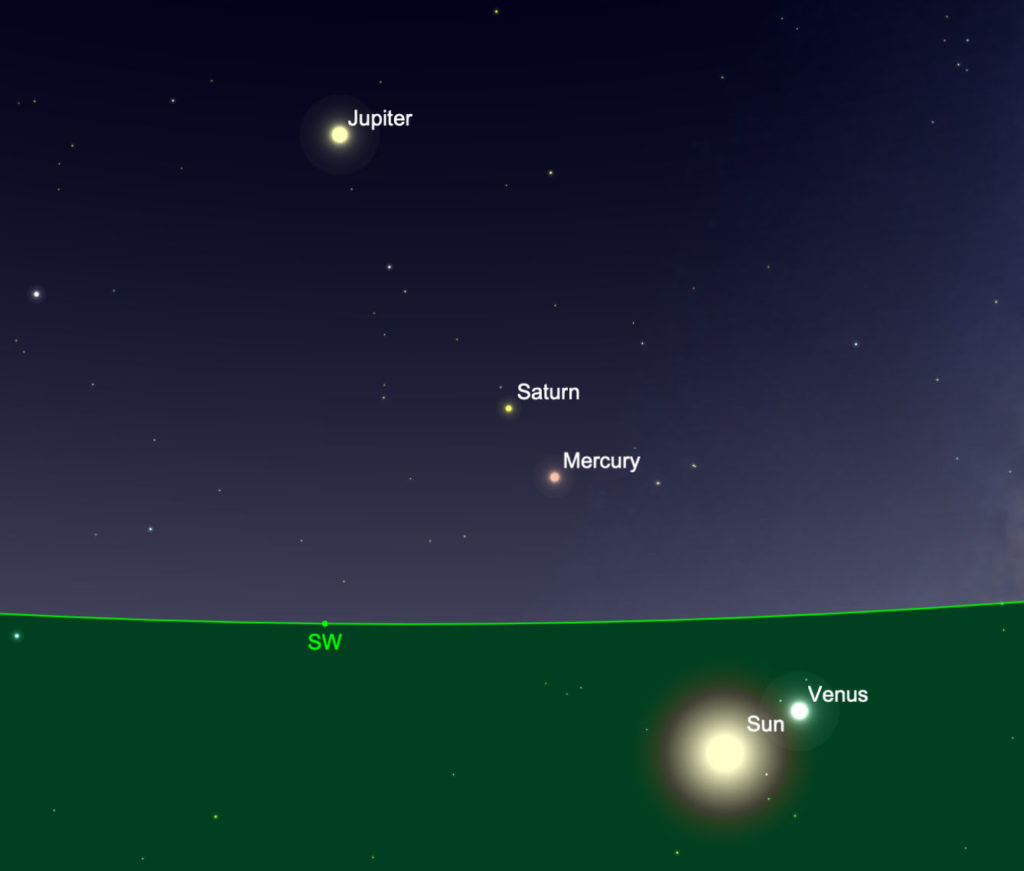Sky Report: January 3 – January 9

The planets 40 minutes after sunset on January 8, when Venus is most nearly in line with the sun and Saturn is 5° above Mercury. Graphic created with SkySafariAstronomy.com.
As predicted, the “Evening Star” – Venus – has left us, and it’s now moving between the earth and sun, soon to reappear as the “Morning Star” during the third week in January. The ancient Greeks called the Venus “Hesperus” when it appeared in the evening and “Phosphorus” when in the morning, although they knew it was the same planet. Venus is closest to being aligned with the sun at 5:52 p.m. MST on January 8th , and then it will be 5° north of the sun. Only rarely does it pass directly in front of the sun; that happened last in 2012 but not again until 2117.
Mercury is trying to compensate for the loss, but it’s a poor second. Still, seldom can you see it at all. Mercury is very low in the southwest in evening twilight. Good nights to look for it are the 7th through 14th when it’s to the lower right of Saturn. Mercury is actually twice as bright as Saturn, but presumably you’ve been following Saturn all along and know where it’s been and where it is. On the 10th through 14th they’re less than 4° apart and you’ll see both planets at the same time through binoculars.
By now Saturn is getting too close to the sun to see easily and we’ll lose it next week.
Jupiter is higher and brighter than both, and it’s now the sole planet that’s conspicuous in the evening sky. Jupiter is the brightest star or planet in the sky.
The moon is near Mercury on the 3rd, but you won’t see either. On the 4th it’s a very thin crescent 5½° straight to the left of Saturn; you’ll see both together in binoculars. On the 5th it’s to the lower left of Jupiter.
The earth is closest to the sun – perihelion – at 11:52 p.m. MST on January 3rd, when the sun is precisely 91,406,842 miles distant, which precisely 3,102,756 miles closer than we will be when at our farthest on July 4. So why is it cold now? Seasons happen because the earth is tilted 23½° causing the sun to ride high in the sky with long days in summer and low in the sky with short days in winter. This is why the seasons are reversed in the Southern Hemisphere; it can’t be high in the sky for both hemispheres at the same time.
Thanks to a 2021 grant from the Utah Governor’s Office of Economic Development and the Kane County Office of Tourism, Stellar Vista Observatory offers portable telescopes and tripod mounted binocular kits on loan for free to all residents of Kane County. Nothing beats a quality binocular or astronomical telescope to enhance enjoyment of the night sky! Visit https://stellarvistaobservatory.org/discover-the-night-sky/ or Kanab City Library for full details.
The Sky Report is presented as a public service by the Stellar Vista Observatory, a nonprofit organization based in Kanab, Utah, which provides opportunities for people to observe, appreciate, and comprehend our starry night sky. Additional information is at www.stellarvistaobservatory.org. Send questions and comments to John@StargazingAdventures.org.






Comments are closed.